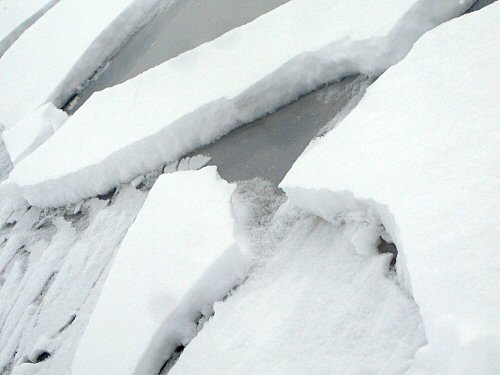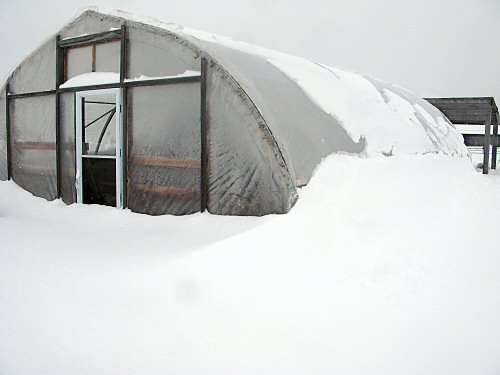
More snow. A few inches, I guess. I don’t pay attention any more, unless there’s too much snow to get out the door… I trudged out into the field, snow up to my knees, to check the greenhouse. It’s doing fine as usual, fully inflated (it has two layers of plastic, with a fan blowing air between) and shedding snow with ease. The greenhouse (and the veggie stand behind it) won’t be moved to the new farm until the snow clears and it’s easy to get at, hopefully sometime in March. I hope dismantling it doesn’t make it fall apart. The plastic is rated for four years, which means the UV resistance should be giving out any time now. I suppose the plastic will start to disintegrate. I don’t really know what happens when greenhouse plastic expires. Guess I’ll find out. Until then, I expect it to last forever! :)





Yes, I think the risk is that it disintegrates, and that the UV deterioration means that if one is using it for light protection for small plants, that part is less effective. But given the large scale of the greenhouse, I’d think that even with some disintegration, you’d get a lot more use out of it still….
It’ll take a while for the plastic to disintegrate, but (I) we noticed that the plants in our house that was past its due date, didn’t grow quite as well and seemed a bit yellower than the other houses. I’d say if your moving it this year and you have enough time, that you should re-skin it.
I was told the 4 yr rating is for more southern climes, with many more full sun days than we in the cold/endless cloudy day climes. I’ve been told to expect my plastic to last up to 7 years before it needs replacing, with luck.
Just wish I had a greenhouse to move! I wish you good luck on moving yours. I think we are past the snow stage and heading into spring…either that or it is just wishful thinking!!! Kim
The poly becomes cloudy and lets in less light. It’s more susceptible to tearing and punctures. It can be hard to detect the diminishing light because it happens slowly. When I uncover a greenhouse I try to reuse the poly for low tunnels. If it only has to keep plants warm on cloudy spring days and over night the amount of sun it lets through doesn’t matter all that much.
Our greenhouse has been holding up ….but we had 11 inches of snow that we had to brush or try to get off. It was a little scary to see all that on our greenhouse but it all worked out fine.
You can check our greenhouse here www.gardendesk.com
Great blog!!
Renee
Say, my yankee friend, you seem very knowledgeable on the subject of plants. So can I ask you a question about tomatoes (they call them ‘maters where I live)?
I have some tomato plants that are about 18-24″ tall and bursting with flowers in my greenhouse. They each live in 1 gallon pots (1 gallon pots that are actually about 1.5 quarts in volume max, but they call them 1 gallon pots… whatever) and are costing me about $2/day to keep alive because I have to heat the greenhouse. There are 75 of them
My question is this: My tomatoes will be easily 4′ tall and laden with fruit by the time late March comes around and I can plant them in the garden. Can I keep them in these tiny containers, or do I have to transplant them into something bigger? Or should I just kill them? I’ve got 50 plants that will be 1’ tall (max) at the end of March anyway. I have to admit that if you say that they need bigger pots, I’ll probably just kill them. They are becoming too much of a pain and are requiring me to mess with them daily.
Cool Greenhouse. I think anything like that would be torn to bits here. The wind gets so ferocious at times.
Thanks for the UV plastic feedback. If we can dismantle the hoophouse without seriously tearing the plastic, I think it’s good for at least a couple more seasons.
I chatted with the owner of the company I got the hoophouse from, he didn’t have much to add, said that general cracking wouldn’t happen till around 10 years, but sooner than that it would start to give where the plastic contacts the metal ribs, due to the heating and cooling. He didn’t know have any specifics about the light transmission, except that it gets worse progressively quicker as time goes buy. He mentioned an interesting number, that the commercial greenhouse grower’s rule of thumb is 1% light transmission loss = 1% production loss, and that light transmission was the most common reason for changing plastic.
His tip for reassembling the house was rotation: inner layer to the outside, and north facing side to the south, which would be least stressed sections to the most exposed areas.
Kevin: I dunno. Those sound like pretty big plants for transplanting. If I had to gamble, I’d start some fresh seedlings immediately, and keep as many of the old guys as I had time and space for as an experiment. I heard that some plants have a very strong root memory, that once they get used to a pot, they’ll stay that size even if transplanted. Toms seem pretty adaptable, but I imagine it might take a while for plants that established to get used to wide open spaces. I’ve planted some tomato seedlings that’ve been held for extra WEEKS in tiny cells, and they took forever to start growing, they may’ve eventually got caught up, but our short season ended before I could find out.
Thanks for the help, Mike! I’m taking your advice and calling this experiment a failure. I’ll keep 5 alive, but I have to let a bunch go because my greenhouse is so tiny. It’s disappointing. My plan was to have tomatoes turning red on March 15 (last frost in LA) before the stink bugs could ruin my crop. *sigh* Oh well.
Thanks again for your opinion.
Mike,
I see a lot of snow build-up around the bottom of the hoophouse…do you ever blow it away? I’m thinking of buying a 2nd hand one and the guy I’m buying it off of said that I should always keep the area around the bottom clear of snow so it doesn’t collapse inwards due to the weight of the snow….but I don’t live where the hoophouse will be and the location is inaccessible (is that a word?) in the wintertime.
Comments?
organicsheri: No, I don’t usually clear around the hoophouse. I may’ve done during the first, cautious winter, don’t remember now, but I haven’t over the last 2-3 winters. I can see a potential cave in problem on the sides, where the plastic slopes in, but because this GH is inflated and offers some resistance and acts as a mold, so the first snow to accumulate sets against it, not really pushing in and down, and acts as a base, keeping additional snow from pressing in. If it got much higher than in the picture, further up the curve, I would clear it, but it hasn’t done that so far.
On the ends, where it’s single plastic, I think the fact that it’s vertical keeps the build-up from being a problem. New snow piling up tends to push down, not in.
On an uninflated hoophouse, I think you’d want to/have to clear it! It’d be more complicated and expensive, but you could build yours with a vertical base, like, 2-3 feet of wood walls first, with the hoops set on top of that. That is one way of building hoophouses.
Inaccessible in winter sounds like a bit a problem, because there’s also snow build-up on top to consider. I’ve pushed off snow that managed to stick right to the top after a big storm. Probably didnt have to, because I didn’t do that the last couple of winters, but again, without inflation to help the snow slide off, build-up at the base won’t be the only concern when there’s lots of snow.